EARTH SCIENCES- WEATHERING AND SOIL
1/74
There's no tags or description
Looks like no tags are added yet.
Name | Mastery | Learn | Test | Matching | Spaced |
|---|
No study sessions yet.
75 Terms
Weathering
Physical or chemical breakdown of rock at or near the the surface to create sediment.
Mass wasting (general idea)
A type of way to transport sediment where the material is transported downhill due to gravity
Erosion (general idea)
Transportation of sediment via water, ice or wind
How many types of weathering?
Two types, mechanical weathering and Chemical weathering
Mechanical weathering and its 3 types
Breaks the rock into smaller pieces
frost wedging
sheeting
biological activity
Mechanical sediment
The final product after mechanical weathering where bits of racks vary in sizes
Mechanical Weathering: Frost Wedging and example in Edmonton
Water enters the rocks cracks and when it freezes it expands by 9% thus exerts pressure and breaks the rock.
This is how potholes are formed in Edmonton
Talus
a pile of broken rocks fall due to gravity at the bottom of a cliff/slope side
Mechanical Weathering: Sheeting
Granite at the surface breaks into sheets and onion like layers
Sheeting is also accomplished due to pressure release and the temperature changing due to the night and day cycle. Where in hot temperatures the outside expands but in cool temperatures the outside shrinks thus it breaks
Exfoliation domes is where sheeting often occurs
Also occurs when crystalline rocks or plutons reach the surface, due to the change in pressure it creates sheeting
Mechanical Weathering: Biological activity
Tree roots breaking rocks or geology students breaking rocks to get samples etc.
Chemical Weathering and factors that affect it
Chemical reaction break up the rocks. Hot and wet environments speed up chemical weathering and it can occur in all environments including polar regions. Morse surface area allows chemical weathering to be more effective
Product of Chemical weathering
End result is chemical sediments where the ions dissolve in water
3 types of chemical weathering
Dissolution, oxidation and hydrolysis
chemical weathering: Dissolution
Because water is polar, the electrostatic forces allows the rock to dissolve the rock. Where the positive end takes the negative end of the rock and vice versa thus breaking down the rock
Pure water dissolves rocks and small amounts of acid can increase dissolution
Chemical weathering: Dissolution examples
Carbonate rocks like limestone(CaCO3) are not soluble in alkali or neutral solutions but do dissolve in acidic solutions.
A weak acid forms when carbon dioxide reacts with water and when its raining this can cause acid rain. (they react midair)
Chemical weathering: Oxidation
main thing is rusting. Rocks like sandstone might contain iron minerals which well breakdown when exposed to the atmosphere. These atoms making the up the minerals in the rocks will separate as the rock rusts away
Chemical weathering: Hydrolysis
hydrogen ions will react with and replace the positive ions like in potassium feldspar. In potassium feldspar, hydrolysis will form clay minerals and potassium and silica ions that’s dissolved in water; making a solution.
Spheroidal weathering
manifestation of chemical weathering where sharp corners have more surface are thus Chemical weathering is more effective here compared to flat surfaces. This produces a smooth shape
Effect of temperature on rock characteristics
Dependant on temperature, different minerals will appear when the rock is formed and these different minerals have different resistance to chemical weathering
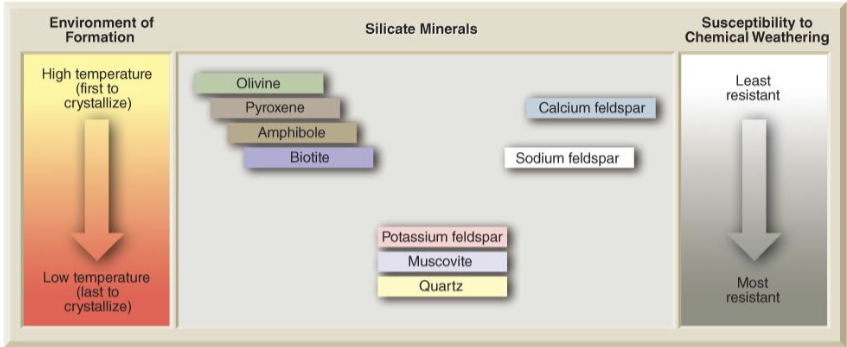
Effect of climate on rate of weathering
At different weathering regions (temperature and annual rain), there might be strong chemical or strong mechanical weathering
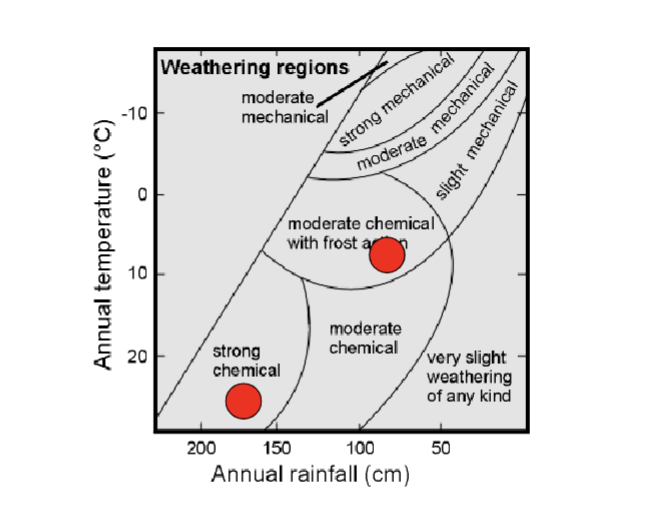
Sediment Classification
Classified by
grain size
Minerology of clasts
sorting(shapes)
Shapes of Clasts(like cubic?)
Depositional environment
Sediment Classification: Grain sizes
Classifying the sediment based on the size of bits
Boulder >256 mm
Cobble 64-256 mm
Pebble 4-64 mm
Granule 2-4 mm
Sand 0.062-2 mm
Slit 0.004-0.062 mm
Clay <0.004 mm
Sediment Classification: Minerology of clasts
Bits of minerals like the ones we from the first set of notes.
Feldspar, quartz, clay minerals etc, but olivine cannot be found as sediment cause its unstable on the surface
Sediment Classification: Sorting and Roundness
When the sediment is poorly sorted, theres different sizes but if theyre properly sorted then all the sediment is the same size.
Roundness: the sediment can either be
angular
subangular
subrounded
rounded
Sediment Classification: Sorting and Roundness process
When sediment gets transported, sorting improves and roundness increases.
Like in a river all of the heavy sediment is left behind while the lighter sediment gets carried away and as the sediment flows the bits will bump into each other and gets rounded out
Poor sorting implies that the there is a short distance of transport
Sediment Classification: Types of Depositional Environment
Continental
Transitional
Marine
Sediment Classification: Continental environment
Glacial deposits, streams, winds (makes sand dunes) and salt lakes. this environment takes sediment and makes specific sedimentary rocks
Sediment Classification: Transitional environment
Tidal flats, beaches, spits lagoons and deltas
Sediment Classification: Marine environment
Continental shelf- shallow up to 200 m and it includes reefs. Due to the water, you’ll get sediments with different densities.
Continental slope:deeper than 200m includes turbidity
4 common types of sediment
Colluvial sediments, Alluvial sediments, Aeolian Sediments and Glacial Sediments.
Colluvial sediments
Sediment that is transported by gravity and is poorly sorted. Typically is boulder, sand and silt with angular roundness
Alluvial sediments
Sediment that is transported by water and is well sorted. Typically made up of sand, silt and clay
Aeolian Sediments
Sediment that is transported by wind and is usually well sorted. Typically is wind-blown sand, silt and dust. This decreases in particle size.
Glacial Sediment
Sediment transported by ice.
Glacial till
mainly clay that is formed under ice
Moraine
a mixture of boulders, gravel, sand and slay carried on top of ice.
Soil in Engineering
Unconsolidated sediments, regolith (loose stuff)
Mechanically weak and grains are not connected. Usually formed locally or transported elsewhere via erosion
Solids characteristics
Some are compressible, some are incompressible and it comes in various forms
Voids
These are holes in the rocks usually occurs due to a gas/air, and liquids like water, brine or contaminants
Thickness of soil in other regions
In the arctic its very thin or non-existent
up to 5m thick in mountains
thickest in sedimentary basins and along major rivers
Layers of soil
As you go down the layers of soil, you go backwards to the past.The image is the layers of soil here in edmonton.
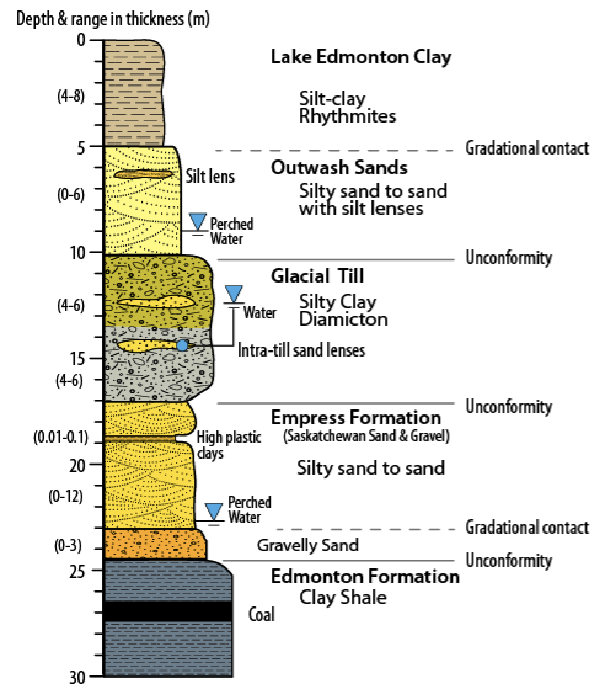
Soil formation overtime
Initially the surface only had sediments but overtime soil forms at the surface
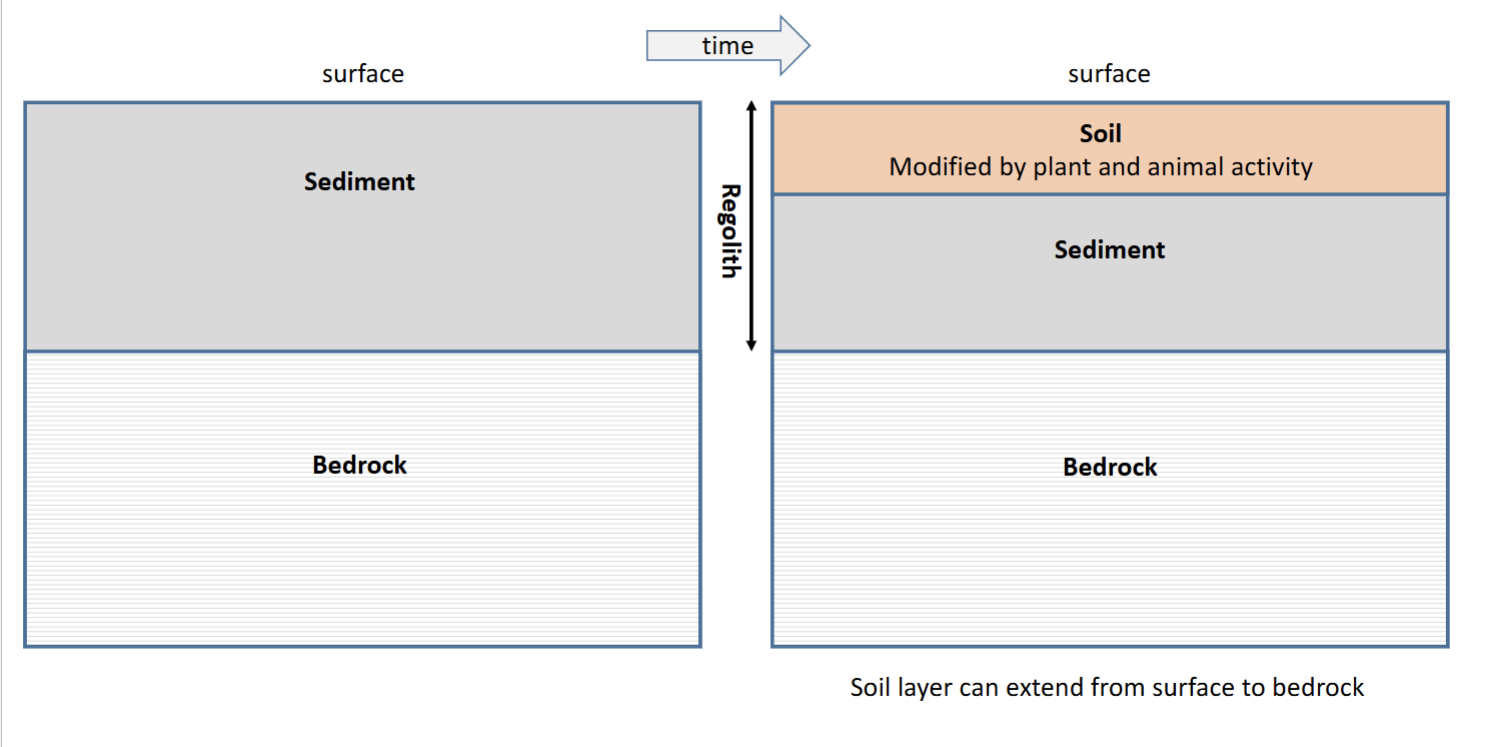
Regolith layers
Soil and sediment layers are the regolith layers
Soil
It is the interface between the lithosphere, biosphere, hydrosphere and atmosphere. It is the combination of mineral and organic material.
Regolith
Layer of rock and mineral fragments formed by weathering unconsolidated material that is weaker than bedrock (loose rocks)
What does good soil contain?
50% mineral matter and humus(decayed animals and plants)
25% air
25% water
Soil formation depends on
Parent material, Time, Climate, Plants and animals and topography
Parent material effects on soil
influences the rate of soil formation, slower on bedrock but faster on unconsolidated material. The chemistry of the parent material controls the chemistry of the soil and affects the fertility. Different climates can produce different types of soil from the same parental material
Residual Soil
The soil from weathering down bedrock, these rocks can be igneous, sedimentary or metamorphic. This is what is considered to be one of the 2 options for parent material
Transported Soil
comes from unconsolidated material and is transferred from other locations. This is what is considered to be one of the 2 options for parent material
Soil formation: Time
Soil formation takes time and initially the soil composition relies on the parent material but overtime climate has a greater effect and changes the composition
Soil formation: Climate
Most important factor, based on temperature and amount of precipitation, where lots of water means that chemical formation occurs.
Soil formation: Plants and animals
In forests or bog there is high amounts of organic content while in desserts there is low amounts of organic content, so the types of soil would be different based on what animals and plants there are
Soil formation: Topography
On a steep slope there is a low moisture content and the soil moves downhill so soil does not develop. But in lowlands there is higher moisture and plenty of time for the soil to develop.
Soil profile
Soil formation starts at the surface and moves downwards. The material moves upwards and downwards as soil is formed. The vertical cross section from the surface to the parent material describing all the layers is called the soil profile.
Horizon
Due to the materials moving upwards and downwards, it creates layers called horizons.
Downward sequence of the layers
The downward sequence is O, A, E, B, C where the layers can vary in thickness.
Horizon: O-Horizon
organic material, can vary from dead leaves to decomposed material, full of microscopic life
Horizon: A-Horizon
Can have bits of organic stuff but its made up to 30% of humus (organic component of soil that results from decomposition of plant and animal material) mineral matter layer
Horizon: E-Horizon
Light coloured layer with little organic material. Water in this layer causes the removal of dissolved materials and washes small particles down and other chemicals are transported through leaching (removing soluble substances)
Horizon: B-Horizon
The precipitates/subsoil. All the washed down material from E horizon is here
Horizon: C-Horizon
Altered parent material
3 types of soil
Pedalfer, pedocal and laterite
Pedalfer
The precipitation is greater than the evaporation and transpiration. Means that more water is soaked into the soil resulting in more leaching compared to what gets evaporated. This type of soil develops in humid/wet climates and there’s enough vegetation to produce acid conditions for leaching (Calcium Carbonate is leached downwards due to this acid).
The B-horizon is enriched with iron oxides and aluminum rich clay.
Pedocal
(cal - calcite = calcium carbonate)- this soil is rich in calcite
Precipitation is less than evaporation and transpiration, soil is super dry due to evaporation occurring more than precipitation.This soil is typically found in dry areas with grassland vegetation. Calcium carbonate is not leached downwards in dry lands but it can be drawn upwards and precipitated.
Laterite
The soil is finished after growing something once. Develops in hot, wet tropical climates. Very intense leaching of calcium carbonate and silica. leaves upper soil concentrated in aluminum and iron that gives it a red colour. Minimal humus and not good for agriculture.
other factors that are important, know this diagram
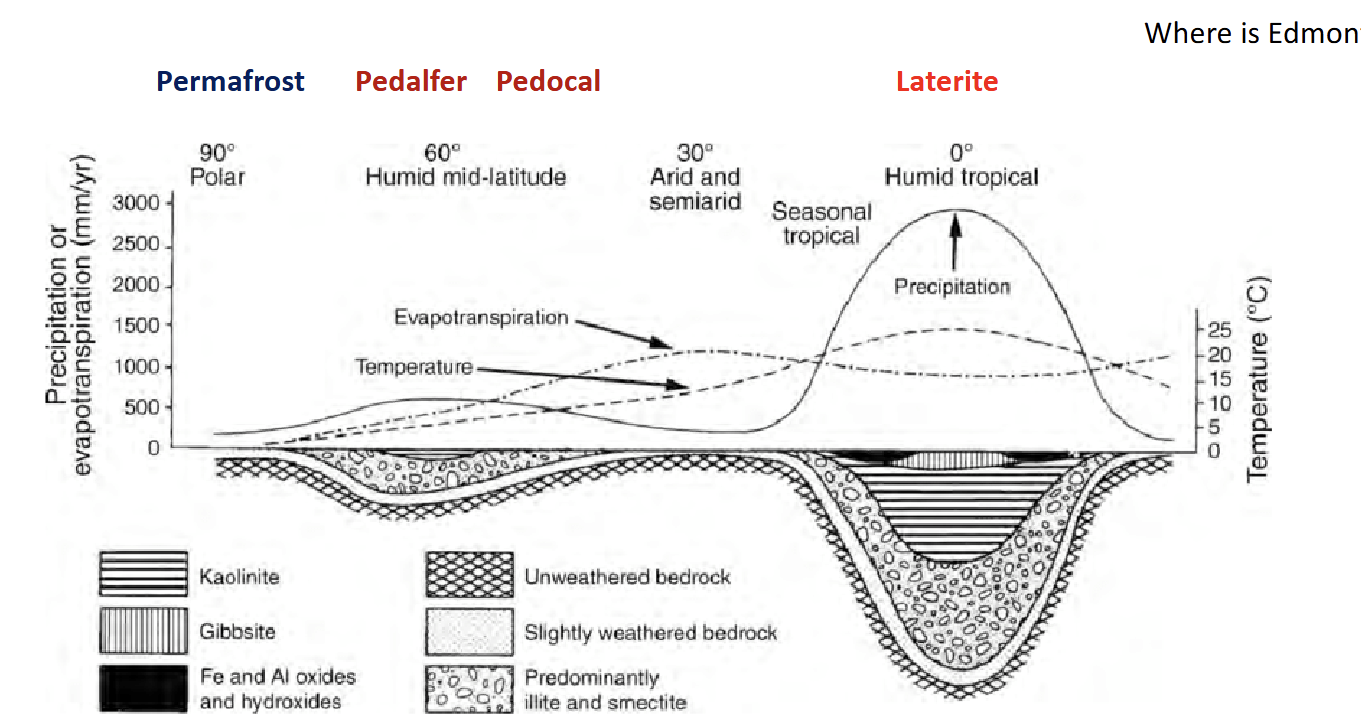
Canadian soil: Chernozemic
Central Alberta has drier climate than northern Alberta so this soil is pedocal. Dark brown-black in colour. Found in cool subarid to subhumid grasslands and forest to grassland transition.
Canadian soil: Luvisolic
Northwest Alberta has wetter climate compared to Rocky mountains isn’t as wet, this soil is pedalfer. Strongly leached A horizon and clay rich B horizon. typically found in deciduous or mixed forests with moderate to cool climate
Canadian soil: Cryosilic
Permafrost region where mature soil does not develop. Found in the tundra landscape dominated by moss and lichens
Soil Erosion: Nature effect
Water or wind can carry the soil away very easily. It can take years to form but only an hour to get rid of it. This is the impact of rain drops carrying away the soil via flowing water (sheet erosion)
Soil erosion: Human Effect
Erosion rates are increased by human activity such as plowing can make it easier for water or wind to carry soil away
importance of soil to civil engineers
This is the foundation for their buildings and need to undertsand the strength and other properties
importance of soil to environmental engineers
important when building landfills, water treatment plants and etc. Soil properties control the flow of water and contamination.
importance of soil to Mining engineers
Soil is removed when mining so restoration requires the understanding of the original soil conditions and the soil properties is important to develop strategies to safely construct stuff and minimize contamination.